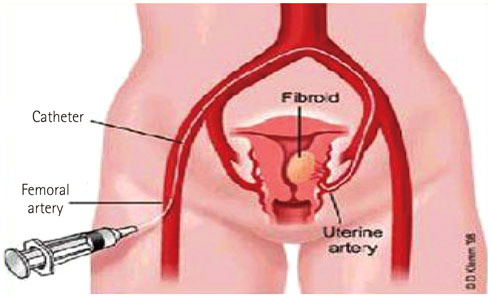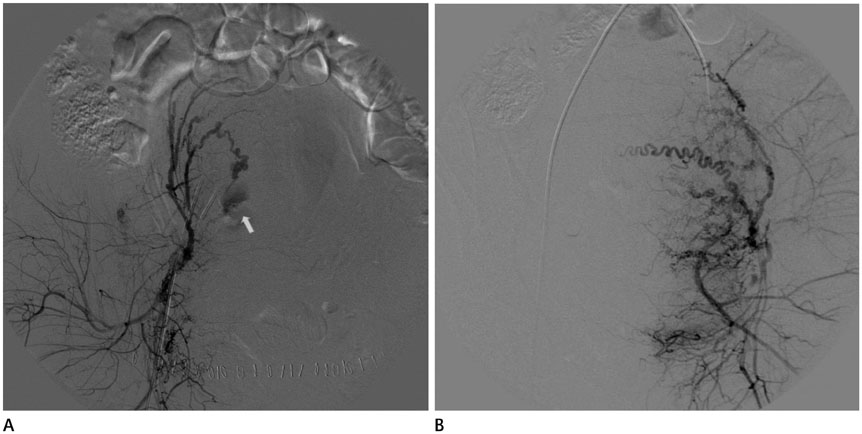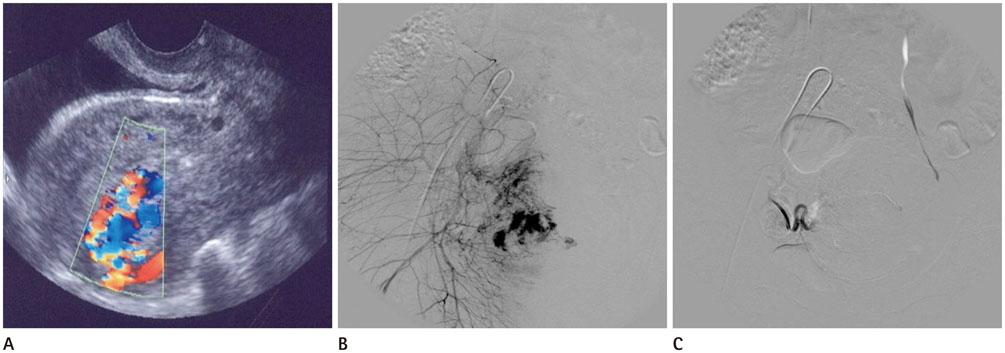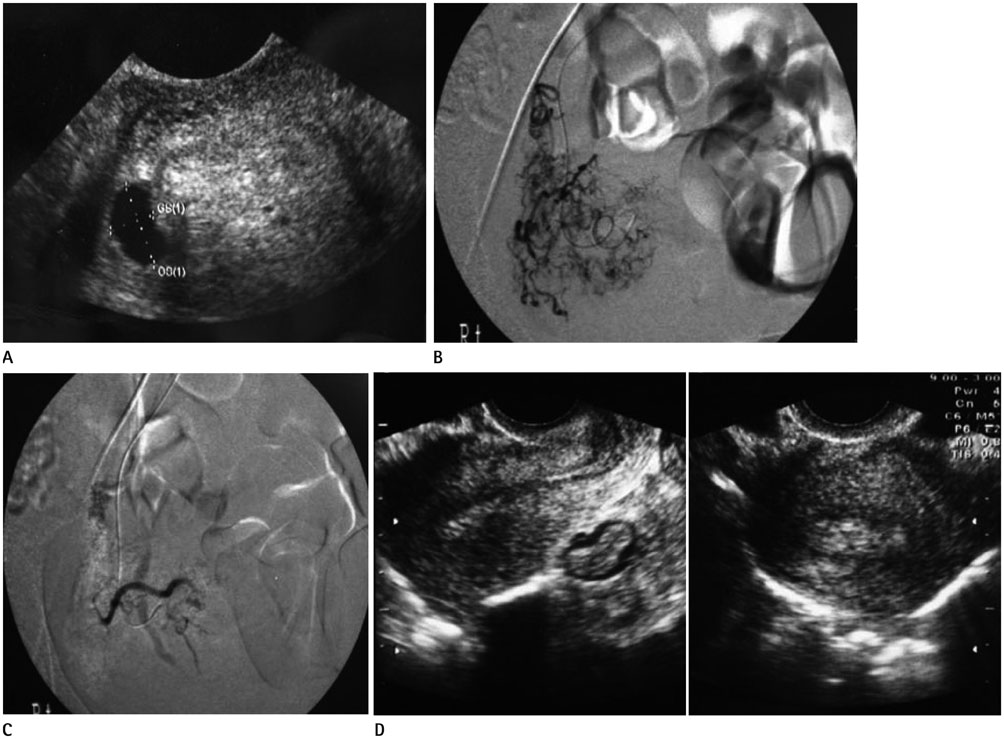J Korean Soc Radiol.
2017 Jan;76(1):1-9. 10.3348/jksr.2017.76.1.1.
Uterine Artery Embolization: The Interventional Treatment of Female Genital Diseases
- Affiliations
-
- 1Department of Radiology, Soonchunhyang University Cheonan Hospital, Cheonan, Korea.
- 2Department of Radiology, Soonchunhyang University Gumi Hospital, Gumi, Korea. ysbysb@sch.ac.kr
- 3Department of Radiology, Soonchunhyang University Seoul Hospital, Seoul, Korea.
- 4Department of Radiology, Soonchunhyang University Bucheon Hospital, Bucheon, Korea.
- 5Department of Radiology, Gangneung Asan Hospital, Gangneung, Korea.
- 6Department of Radiology, Chungnam National University College of Medicine, Chungnam National University Hospital, Daejeon, Korea.
- 7Department of Radiology, Presbyterian Medical Center, Jeonju, Korea.
- KMID: 2365045
- DOI: http://doi.org/10.3348/jksr.2017.76.1.1
Abstract
- The uterus is the major female sex organ and is essential for pregnancy. The organ is located in the pelvic cavity. It is usually fist-sized with its volume changing from 75 to 200 cc depending on the menstrual cycle. There are various diseases associated with the uterus, including malignancy, uterine myoma, postpartum hemorrhage, and vascular malformation. The conventional surgical treatment for these diseases is hysterectomy. However, hysterectomy has some risk, and there may be complications associated with the surgery and anesthesia. In addition, hysterectomy results in loss of fertility and loss of female characteristics, both of which may lead to emotional problems. After uterine artery embolization (UAE) was performed for post-partum bleeding in 1979 and for uterine myoma in 1995, interventional treatment of UAE replaced the existing surgical treatment of hysterectomy. UAE is performed widely as a minimally invasive treatment modality that can preserve the uterus, make pregnancy and childbirth possible and resolve emotional problems. The interventional treatment has become increasingly popular to treat various female genital diseases.
MeSH Terms
Figure
Cited by 2 articles
-
Clinical and Angiographic Features of Secondary Postpartum Hemorrhage and the Outcomes of Transcatheter Arterial Embolization
Seung Dae Baek, Ung Rae Kang, Seung Woo Ji, Young Hwan Kim, Jung Guen Cha
J Korean Soc Radiol. 2018;79(6):315-322. doi: 10.3348/jksr.2018.79.6.315.Uterine Artery Embolization in Patients with PostpartumHemorrhage: Clinical Efficacy and Safety of Treatment with N-Butyl-2-Cyanoacrylate
Yohan Kwon, Young Ho So, Byoung Jae Kim, Sun Min Kim, Young Ho Choi, Min Hoan Moon
J Korean Soc Radiol. 2019;80(1):88-97. doi: 10.3348/jksr.2019.80.1.88.
Reference
-
1. Buttram VC Jr, Reiter RC. Uterine leiomyomata: etiology, symptomatology, and management. Fertil Steril. 1981; 36:433–445.2. Verkauf BS. Myomectomy for fertility enhancement and preservation. Fertil Steril. 1992; 58:1–15.3. Itkin M, Shlansky-Goldberg R. Uterine fibroid embolization for the treatment of symptomatic leiomyomata. Appl Radiol. 2002; 31:9–17.4. Sutton CJ. Treatment of large uterine fibroids. Br J Obstet Gynaecol. 1996; 103:494–496.5. Hutchins FL Jr. Abdominal myomectomy as a treatment for symptomatic uterine fibroids. Obstet Gynecol Clin North Am. 1995; 22:781–789.6. Rossetti A, Sizzi O, Soranna L, Cucinelli F, Mancuso S, Lanzone A. Long-term results of laparoscopic myomectomy: recurrence rate in comparison with abdominal myomectomy. Hum Reprod. 2001; 16:770–774.7. Ravina JH, Herbreteau D, Ciraru-Vigneron N, Bouret JM, Houdart E, Aymard A, et al. Arterial embolisation to treat uterine myomata. Lancet. 1995; 346:671–672.8. Spies JB, Ascher SA, Roth AR, Kim J, Levy EB, Gomez-Jorge J. Uterine artery embolization for leiomyomata. Obstet Gynecol. 2001; 98:29–34.9. McLucas B, Adler L, Perrella R. Uterine fibroid embolization: nonsurgical treatment for symptomatic fibroids. J Am Coll Surg. 2001; 192:95–105.10. Pron G, Bennett J, Common A, Wall J, Asch M, Sniderman K. The Ontario Uterine Fibroid Embolization Trial. Part 2. Uterine fibroid reduction and symptom relief after uterine artery embolization for fibroids. Fertil Steril. 2003; 79:120–127.11. Goodwin SC, McLucas B, Lee M, Chen G, Perrella R, Vedantham S, et al. Uterine artery embolization for the treatment of uterine leiomyomata midterm results. J Vasc Interv Radiol. 1999; 10:1159–1165.12. Spies JB, Scialli AR, Jha RC, Imaoka I, Ascher SM, Fraga VM, et al. Initial results from uterine fibroid embolization for symptomatic leiomyomata. J Vasc Interv Radiol. 1999; 10:1149–1157.13. Pelage JP, Guaou NG, Jha RC, Ascher SM, Spies JB. Uterine fibroid tumors: long-term MR imaging outcome after embolization. Radiology. 2004; 230:803–809.14. Omary RA, Vasireddy S, Chrisman HB, Ryu RK, Pereles FS, Carr JC, et al. The effect of pelvic MR imaging on the diagnosis and treatment of women with presumed symptomatic uterine fibroids. J Vasc Interv Radiol. 2002; 13:1149–1153.15. Burn PR, McCall JM, Chinn RJ, Vashisht A, Smith JR, Healy JC. Uterine fibroleiomyoma: MR imaging appearances before and after embolization of uterine arteries. Radiology. 2000; 214:729–734.16. Das R, Champaneria R, Daniels JP, Belli AM. Comparison of embolic agents used in uterine artery embolisation: a systematic review and meta-analysis. Cardiovasc Intervent Radiol. 2014; 37:1179–1190.17. Spies JB, Spector A, Roth AR, Baker CM, Mauro L, Murphy-Skrynarz K. Complications after uterine artery embolization for leiomyomas. Obstet Gynecol. 2002; 100(5 Pt 1):873–880.18. Hovsepian DM, Siskin GP, Bonn J, Cardella JF, Clark TW, Lampmann LE, et al. Quality improvement guidelines for uterine artery embolization for symptomatic leiomyomata. J Vasc Interv Radiol. 2004; 15:535–541.19. Yang SB, Jung YJ, Goo DE, Jang YW. Usefulness of modified intravenous analgesia: Initial experience in uterine artery embolization for leiomyomata. J Korean Radiol Soc. 2006; 54:259–264.20. Nalaboff KM, Pellerito JS, Ben-Levi E. Imaging the endometrium: disease and normal variants. Radiographics. 2001; 21:1409–1424.21. Hovsepian DM, Siskin GP, Bonn J, Cardella JF, Clark TW, Lampmann LE, et al. Quality improvement guidelines for uterine artery embolization for symptomatic leiomyomata. Cardiovasc Intervent Radiol. 2004; 27:307–313.22. Chrisman HB, Saker MB, Ryu RK, Nemcek AA Jr, Gerbie MV, Milad MP, et al. The impact of uterine fibroid embolization on resumption of menses and ovarian function. J Vasc Interv Radiol. 2000; 11:699–703.23. Marx M, Wack JP, Baker EL, Stevens SK, Barakos JA. Ovarian protection by occlusion of uteroovarian collateral vessels before uterine fibroid embolization. J Vasc Interv Radiol. 2003; 14:1329–1332.24. Razavi MK, Wolanske KA, Hwang GL, Sze DY, Kee ST, Dake MD. Angiographic classification of ovarian artery-to-uterine artery anastomoses: Initial observations in uterine fibroid embolization. Radiology. 2002; 224:707–712.25. Yang SB, Im HH, Chang YW, Goo DE. Ovarian protection by selective coil embolization of a uteroovarian anastomosis before uterine fibroid embolization: a report of two cases. J Korean Radiol Soc. 2006; 55:229–233.26. Abbara S, Spies JB, Scialli AR, Jha RC, Lage JM, Nikolic B. Transcervical expulsion of a fibroid as a result of uterine artery embolization for leiomyomata. J Vasc Interv Radiol. 1999; 10:409–411.27. Worthington-Kirsch RL, Hutchins FL Jr, Berkowitz RP. Regarding sloughing of fibroids after uterine artery embolization. J Vasc Interv Radiol. 1999; 10:1135.28. Berkowitz RP, Hutchins FL Jr, Worthington-Kirsch RL. Vaginal expulsion of submucosal fibroids after uterine artery embolization. A report of three cases. J Reprod Med. 1999; 44:373–337.29. Walker WJ, Pelage JP. Uterine artery embolisation for symptomatic fibroids: clinical results in 400 women with imaging follow up. BJOG. 2002; 109:1262–1272.30. Spies JB, Roth AR, Jha RC, Gomez-Jorge J, Levy EB, Chang TC, et al. Leiomyomata treated with uterine artery embolization: factors associated with successful symptom and imaging outcome. Radiology. 2002; 222:45–52.31. McLucas B, Adler L, Perrella R. Predictive factors for success in uterine fibroid embolization. Min Invas Ther Allied Technol. 1999; 8:429–432.32. Pelage JP, Le Dref O, Soyer P, Kardache M, Dahan H, Abitbol M, et al. Fibroid-related menorrhagia: treatment with superselective embolization of the uterine arteries and midterm follow-up. Radiology. 2000; 215:428–431.33. Katsumori T, Nakajima K, Mihara T. Is a large fibroid a high-risk factor for uterine artery embolization? AJR Am J Roentgenol. 2003; 181:1309–1314.34. Fleischer AC, Donnelly EF, Campbell MG, Mazer MJ, Grippo D, Lipsitz NL. Three-dimensional color Doppler sonography before and after fibroid embolization. J Ultrasound Med. 2000; 19:701–705.35. Lipman JC, Smith SJ, Spies JB, Siskin GP, Machan LS, Bonn J, et al. IV. Uterine fibroid embolization: follow-up. Tech Vasc Interv Radiol. 2002; 5:44–45.36. Weintraub JL, Romano WJ, Kirsch MJ, Sampaleanu DM, Madrazo BL. Uterine artery embolization: sonographic imaging findings. J Ultrasound Med. 2002; 21:633–637. quiz 639-640.37. Yang SB, Lee SJ, Choi GC, Im HH, Goo DE, Lee HK, et al. Hounsfield number measurement after a uterine fibroid embolization: significance as a predictive factor of embolization success. J Korean Radiol Soc. 2008; 59:13–20.38. Tropeano G, Di Stasi C, Litwicka K, Romano D, Draisci G, Mancuso S. Uterine artery embolization for fibroids does not have adverse effects on ovarian reserve in regularly cycling women younger than 40 years. Fertil Steril. 2004; 81:1055–1061.39. Ravina JH, Vigneron NC, Aymard A, Le Dref O, Merland JJ. Pregnancy after embolization of uterine myoma: report of 12 cases. Fertil Steril. 2000; 73:1241–1243.40. Vegas G, Illescas T, Muñoz M, Pérez-Piñar A. Selective pelvic arterial embolization in the management of obstetric hemorrhage. Eur J Obstet Gynecol Reprod Biol. 2006; 127:68–72.41. Combs CA, Murphy EL, Laros RK Jr. Factors associated with hemorrhage in cesarean deliveries. Obstet Gynecol. 1991; 77:77–82.42. Pelage JP, Soyer P, Repiquet D, Herbreteau D, Le Dref O, Houdart E, et al. Secondary postpartum hemorrhage: treatment with selective arterial embolization. Radiology. 1999; 212:385–389.43. Shevell T, Malone FD. Management of obstetric hemorrhage. Semin Perinatol. 2003; 27:86–104.44. Deux JF, Bazot M, Le Blanche AF, Tassart M, Khalil A, Berkane N, et al. Is selective embolization of uterine arteries a safe alternative to hysterectomy in patients with postpartum hemorrhage? AJR Am J Roentgenol. 2001; 177:145–149.45. Seror J, Allouche C, Elhaik S. Use of Sengstaken-Blakemore tube in massive postpartum hemorrhage: a series of 17 cases. Acta Obstet Gynecol Scand. 2005; 84:660–664.46. Danso D, Reginald P. Combined B-lynch suture with intrauterine balloon catheter triumphs over massive postpartum haemorrhage. BJOG. 2002; 109:963.47. Salomon LJ, deTayrac R, Castaigne-Meary V, Audibert F, Musset D, Ciorascu R, et al. Fertility and pregnancy outcome following pelvic arterial embolization for severe post-partum haemorrhage. A cohort study. Hum Reprod. 2003; 18:849–852.48. Soyer P, Dohan A, Dautry R, Guerrache Y, Ricbourg A, Gayat E, et al. Transcatheter arterial embolization for postpartum hemorrhage: indications, technique, results, and complications. Cardiovasc Intervent Radiol. 2015; 38:1068–1081.49. Gilbert L, Porter W, Brown VA. Postpartum haemorrhage--a continuing problem. Br J Obstet Gynaecol. 1987; 94:67–71.50. Ko SF, Lin H, Ng SH, Lee TY, Wan YL. Postpartum hemorrhage with concurrent massive inferior epigastric artery bleeding after cesarean delivery. Am J Obstet Gynecol. 2002; 187:243–244.51. Goffinet F, Haddad B, Carbonne B, Sebban E, Papiernik E, Cabrol D. [Practical use of sulprostone in the treatment of hemorrhages during delivery]. J Gynecol Obstet Biol Reprod (Paris). 1995; 24:209–216.52. Grivell RM, Reid KM, Mellor A. Uterine arteriovenous malformations: a review of the current literature. Obstet Gynecol Surv. 2005; 60:761–767.53. Ophir E, Singer-Jordan J, Oettinger M, Odeh M, Tendler R, Feldman Y, et al. Uterine artery embolization for management of interstitial twin ectopic pregnancy: case report. Hum Reprod. 2004; 19:1774–1777.54. Deruelle P, Lucot JP, Lions C, Robert Y. Management of interstitial pregnancy using selective uterine artery embolization. Obstet Gynecol. 2005; 106(5 Pt 2):1165–1167.55. Siskin GP, Tublin ME, Stainken BF, Dowling K, Dolen EG. Uterine artery embolization for the treatment of adenomyosis: clinical response and evaluation with MR imaging. AJR Am J Roentgenol. 2001; 177:297–302.56. Pelage JP, Jacob D, Fazel A, Namur J, Laurent A, Rymer R, et al. Midterm results of uterine artery embolization for symptomatic adenomyosis: initial experience. Radiology. 2005; 234:948–953.57. Kim MD, Kim S, Kim NK, Lee MH, Ahn EH, Kim HJ, et al. Long-term results of uterine artery embolization for symptomatic adenomyosis. AJR Am J Roentgenol. 2007; 188:176–181.58. Samina NM, Muhammad S. Role of uterine artery embolization in the management of cervical cancer: review article. J Cancer Sci Ther. 2012; 4:167–169.
- Full Text Links
- Actions
-
Cited
- CITED
-
- Close
- Share
- Similar articles
-
- A Case of Uterine Fibroids Necrosis after Transarterial Embolization for Treatment of Uterine Fibroids
- A Case of Vaginal Expulsion of Submucosal Fibroid after Uterine Artery Embolization
- A case of uterine artery embolization for treatment of huge uterine myoma
- Spontaneous Uterine Rupture after Uterine Artery Embolization for the Treatment of Uterine Myomas
- Fatal pulmonary thromboembolism after uterine artery embolization for uterine myoma: A case report






